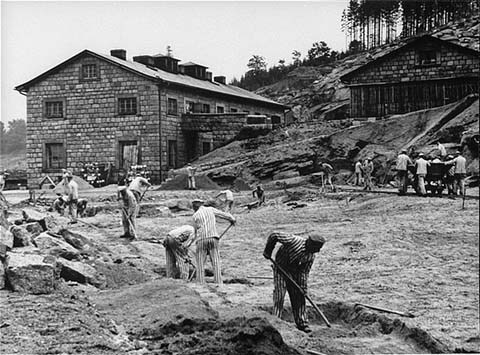Living Conditions of Auschwitz

Main entrance and railroad tracks at Auschwitz.
In the concentration camp, Auschwiz, the conditions were horrible because of the crammed housing, activities and work were excrushiating, and the ways of killing so many people. In Auschwitz , prisoners lived in old brick barracks. Several hundred three-tier wooden bunk beds were installed in each building. The overcrowding in Auschwitz forced basements and lofts into use as living quarters. Work was very hard and painful to prisoners. About every hour, 400 to 500 people would die from Concentration Camps. Even children were killed along with millions of adults.
The Housing
Prisoners of the Nazi regime lived in harsh conditions in concentration camps. The shelters the prisoners stayed in were called barracks (Burch). Most mattresses that they slept on were burlap filled with straw (Burch). Investigators say, “Some of the barracks could only hold 25 people and the Nazis tripled that amount,” (Burch). Bunks usually could hold three people, but they squeezed ten people to a bunk at time(AUSCHWITZ). Prisoners were crammed into these tiny spaces and could not move. Approximately 150,000 of the prisoners at Auschwitz were too weak to move, so they sometimes would stay in a crammed barrack until they died (AUSCHWITZ).
Work and Activities for Prisoners
Work and Activities in Auschwitz concentration Camp was hard and excruciating. Prisoners had to carry beams of steel for no reason; the officers just enjoyed watching the prisoners doing hard work (Witherbee). If a prisoner did not listen or talked out they would be killed, sometimes automatically (Burch). There were over 300 prisoners working at one place at the same time (Witherbee). A Holocaust survivor exclaimed, “Officers seemed to take delight in being cruel to the other prisoners” (Leapman). The work day for the Jews began around 4:00 a.m. to 5:00a.m. and if someone that had to work did not get up they would be killed(Burch). Workers work days were long and tiring.

Prisoners working at Auschwitz.
Gas Chambers and Ovens
Gas chambers and ovens are a very disturbing part of the Holocaust. Officers would take around 200 people and tell them they were taking showers, but they were really going into the gas chambers to be killed (AUSCHWITZ). A survivor declared, “There were shower heads in the gas chambers, but the shower heads were used as props” (Auschwitz Gas Chambers). The crematoriums let off a horrible smell. After the prisoners were killed, the Nazi’s would burn the bodies in ovens (AUSCHWITZ). About 5 to 6 people were burned at a time (AUSCHWITZ). In the gas chambers, the prisoners were either showered with carbon monoxide or Zyklon B, which almost immediately killed the Jews (Burch). Officers could see everything that was going on inside the gas chambers through the hole they drop the poisonous gas through (AUSCHWITZ). Gas chambers were a crucial way of killing prisoners in Auschwitz Concentration Camp.

Ovens in Auschwitz used to cremate people after death.
Works Cited.
AUSCHWITZ: THE FINAL SOLUTION BBC clip 1/5. youtube. Web0. <http://www.youtube.com>. 6
Burch, Christa. “Conditions in the Nazi Concentration Camps.” THE Holocaust. N.p., n.d. Web. 2 May 2010. <http://home.snu.edu/~dwilliam/s98/holocaust/conditionsinnaziconcentrationcamps.html>. 1
Guard tower, Auschwitz, Poland. N.d. United streaming. Discovery Education, 2005. Web. 10 May 2010. http://player.discoveryeducation.com.
AUSCHWITZ, Raul. “Concentration Camp.” Encyclopedia Americana. Scholastic Inc., n.d. Web. 3 May 2010. <http://go.grolier.com/>. 3
Leapman, Michael. Witnesses to war. New York, NY: Scholastic Inc., 1998. Print. 7
AUSCHWITZ in concentration camps. Discovery Education streaming. Web. 5 May 2010. <http://streaming.discoveryeducation.com>. 5
Ovens in a German concentration camp. N.d. discovery education. Discovery Education, 2005. Web. 10 May 2010. http://player.discoveryeducation.com.
Shuter, Jane. Prelude to the Holocaust. Chicago: Read Education and Professional Publishing, 2003. Print. 9
Soumeral, Eve Nussbaum. Daily Life During the Holocaust. West Port, Conneticut: The green House Press, 1998. Print. 4
Witherbee, Amy. “Chapter two: Concentration Camps and Mass Murder.” Middle Search Plus. N.p., n.d. Web. 2 May 2010. <http://web.ebscohost.com>. 2
Witness: Voices from the Holocaust. Dir. Joshua M. Greene. Dsicovery Education. Web. 7 May 2010. <http://player.discoveryeducation.com/index.cfm?
guidAssetId=FAB9F311-33E3-408D-9BF1-0026B2F2FA98&blnFromSearch=1&productcode=US>. 8
WWII Europe Poland Concentration Camp, Auschwitz. 14 Dec. 1964. Ap images. The Associated Press., 8 Dec. 2008. Web. 10 May 2010. <http://apimages.ap.org>.
Return to Home Page
Created by: Clifford

Comments (0)
You don't have permission to comment on this page.